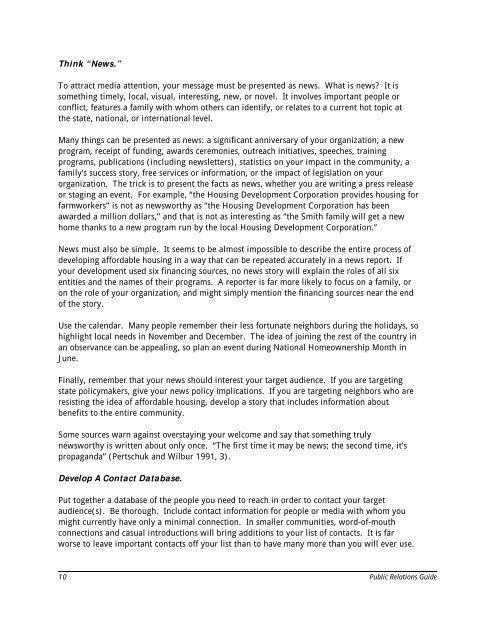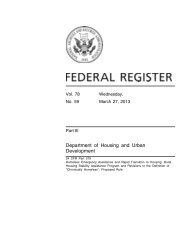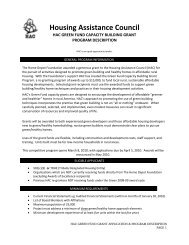Public Relations Guide for Rural Housing Organizations (manual
Public Relations Guide for Rural Housing Organizations (manual
Public Relations Guide for Rural Housing Organizations (manual
Create successful ePaper yourself
Turn your PDF publications into a flip-book with our unique Google optimized e-Paper software.
Think “News.”To attract media attention, your message must be presented as news. What is news? It issomething timely, local, visual, interesting, new, or novel. It involves important people orconflict, features a family with whom others can identify, or relates to a current hot topic atthe state, national, or international level.Many things can be presented as news: a significant anniversary of your organization, a newprogram, receipt of funding, awards ceremonies, outreach initiatives, speeches, trainingprograms, publications (including newsletters), statistics on your impact in the community, afamily’s success story, free services or in<strong>for</strong>mation, or the impact of legislation on yourorganization. The trick is to present the facts as news, whether you are writing a press releaseor staging an event. For example, “the <strong>Housing</strong> Development Corporation provides housing <strong>for</strong>farmworkers” is not as newsworthy as “the <strong>Housing</strong> Development Corporation has beenawarded a million dollars,” and that is not as interesting as “the Smith family will get a newhome thanks to a new program run by the local <strong>Housing</strong> Development Corporation.”News must also be simple. It seems to be almost impossible to describe the entire process ofdeveloping af<strong>for</strong>dable housing in a way that can be repeated accurately in a news report. Ifyour development used six financing sources, no news story will explain the roles of all sixentities and the names of their programs. A reporter is far more likely to focus on a family, oron the role of your organization, and might simply mention the financing sources near the endof the story.Use the calendar. Many people remember their less <strong>for</strong>tunate neighbors during the holidays, sohighlight local needs in November and December. The idea of joining the rest of the country inan observance can be appealing, so plan an event during National Homeownership Month inJune.Finally, remember that your news should interest your target audience. If you are targetingstate policymakers, give your news policy implications. If you are targeting neighbors who areresisting the idea of af<strong>for</strong>dable housing, develop a story that includes in<strong>for</strong>mation aboutbenefits to the entire community.Some sources warn against overstaying your welcome and say that something trulynewsworthy is written about only once. “The first time it may be news; the second time, it’spropaganda” (Pertschuk and Wilbur 1991, 3).Develop A Contact Database.Put together a database of the people you need to reach in order to contact your targetaudience(s). Be thorough. Include contact in<strong>for</strong>mation <strong>for</strong> people or media with whom youmight currently have only a minimal connection. In smaller communities, word-of-mouthconnections and casual introductions will bring additions to your list of contacts. It is farworse to leave important contacts off your list than to have many more than you will ever use.10 <strong>Public</strong> <strong>Relations</strong> <strong>Guide</strong>









